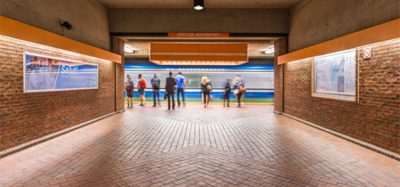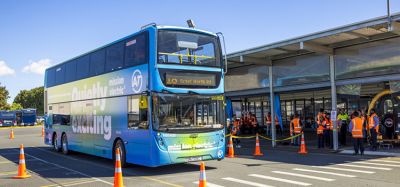Automated Metros: Where is the driver?
- Like
- Digg
- Del
- Tumblr
- VKontakte
- Buffer
- Love This
- Odnoklassniki
- Meneame
- Blogger
- Amazon
- Yahoo Mail
- Gmail
- AOL
- Newsvine
- HackerNews
- Evernote
- MySpace
- Mail.ru
- Viadeo
- Line
- Comments
- Yummly
- SMS
- Viber
- Telegram
- Subscribe
- Skype
- Facebook Messenger
- Kakao
- LiveJournal
- Yammer
- Edgar
- Fintel
- Mix
- Instapaper
- Copy Link
Posted: 4 July 2014 | Marc-André Klemenz and Florian Norrenbrock, DB International GmbH | No comments yet
Driver operated metro systems are still the dominant system around the world. However, operators are now more frequently operating fully or partially automated trains, especially for newly-built lines. Replacement of previous lines with new signalling, infrastructure and rolling stock is an increasing process for many metro systems. For Intelligent Transport, Marc-André Klemenz and Florian Norrenbrock from DB International GmbH cover the different operational aspects of automated metros…
A ‘state-of-the-art’ metro system is one that is operated with driverless vehicles, and many metros worldwide now operate with driverless trains as they can help to reduce the operational costs and of improving the frequency of services as well as improving overall safety.
There may be concerns that some passengers could be reluctant to travel on driverless or unattended trains. However, this concern is seen to be more of a perception than a reality given the widespread acceptance of such systems by passengers around the world and the proven safety record of such systems.
Grade of Automation (GoA)
In general there are two basic types for the automation of metros systems: driverless and with driver. These systems are then divided into five types of ‘Grade of Automation’ according to EN 62290.
On-sight train operation, GoA0
When operating under this system, the train driver must ensure the safe movement of the train, i.e. ensure a safe route, ensure the safe separation of trains, and ensure a safe speed.
In fact, the train driver must drive and operate the train whilst supervising the guide way of the train on the track. In the stations, the operating staff must supervise passenger transfer.
Finally, the train driver is responsible for the safety of the train. This contains the detections and management of emergency situations.
Non-automated train operation, GoA1
When operating under this system, the train control system is responsible to ensure the safe route and safe separation of the trains.
All the rest of the necessary functions to operate and drive the train in a safe way, has to be controlled by the operations staff.
Semi-automated train operation, GoA2
In comparison to the non-automated train operation system, the automation system is additionally responsible for acceleration and the braking control of the train. This means that the driver is not responsible for driving the train. The operating staff are responsible for: supervising the guide way; supervising station passenger transfer; operating the train (set-in/set-off operation and supervise status of the train); and ensuring detection and management of emergency situations.
Driverless train operation, GoA3
Driverless train operation does not need any train driver. All necessary functions will be controlled by the system. In order to supervise the passenger transfer, operate the train and ensure the detection and management of emergency situations, a train attendant will therefore be necessary.
Unattended train operation, GoA4
Unattended train operation does not need a train attendant on-board the trains. All necessary functions for the safe operation of the system, including supervising the passenger transfer and train operation, will be performed by the system.
The detection and management of emergency situations will be controlled by staff within the operation control centre (OCC) or by the system itself.
Apart from the savings in staff costs, the greatest benefit of GoA4 is that train service can be tailored directly to demand with trains being brought into service as and when the demand increases.
Operational aspects
There are several differences for the operation of driverless systems and of systems with a driver.
Headway and frequency
The headway of a railway system depends on the technical layout of the systems. For conventional metro systems with a driver, the headway is limited by block sections, in contrast to ATO systems where the headway is limited by the braking and safety distance of the system.
The main benefits of a driverless system include a shorter headway/higher frequency, plus a higher transport capacity.
Turnaround time
Driverless systems allow short turnaround times. In these systems the time can be the same as the dwell time and does not depend on the human factor of the train driver. Especially in case of disturbances and delays, the transferring of delays can be minimised or even eliminated.
Energy saving
The strategy of coasting and energy saving driving with driverless systems is easier to achieve than with a system with a driver. The human factor and individual behaviours can prevent an energy saving driving strategy.
The driverless operation ensures the implementation of an energy optimal operational programme. So the power supply system might be less stressed and the energy consumption can be reduced.
Dwell time
The strategy of a punctual departure with GoA4 systems is easier to achieve than with a system with a driver. The individual behaviours of the driver can lead to changes (longer or shorter) of the dwell time.
Degraded mode
Systems with driver/train attendants will not increase the train availability and avoid degraded modes. Technical failures can be solved by the staff in the stations or technical teams in readiness. Driverless systems enable a high level of service and an optimal usage of the rolling stock during degraded modes.
Advantages of driverless systems include:
- Easy dispatching of the rolling stock, without the need to deploy staff
- Driverless systems availability of predefined operational modes and predefined alternative timetables. In case of degrades, it is possible to switch over from normal operation/regular timetable to a defined degraded mode
- No time-consuming communication with train driver during degraded modes
- Short times to change from normal mode in predefined degraded modes.
In case of a train failure, technical staff could be required on-board the train to solve the failure.
Emergency
It is worth remembering that emergency situations can occur, even if the availability of a system is over 99%. In general there are two important cases which impact the train operation:
- Driver/staff on-board the train are continuously available throughout an emergency. In this case, the staff (driver and attendant) can inform the passengers, can coordinate necessary evacuations and can ensure the safety of passengers
- Driver/staff is not available on the train. These emergency situations are mostly heavy accidents. In this case the passengers have to evacuate the train themselves and rely on the information from the OCC. The overall evacuation or further measures will be managed by external parties. This is the normal procedure also for driverless systems in each emergency case.
In conclusion, systems with a driver or a train attendant will not increase the train availability and safety of the system itself, but could significantly increase passenger safety.
Safety and security
The long list of actual driverless metros throughout the world shows that risks connected to driverless operation can generally be considered as understood and controlled. Three different types of operation related to this topic are as follows:
Conventional operation with driver
Every train is provided with a driver being placed at the front to manually drive the train or supervise an automatic driving programme; both options are regarded equal from the point of safety and security as differences only concern the quality of operation.
Driverless operation but a train guard accompanies the train
In contrary to the ‘conventional operation with driver’ option, the train guard is not located in the front of the train. They may be concerned with supervising of passengers but will also be trained to drive the train manually in case of disruptions.
Fully driverless operation
No staff concerned with the safe operation of the train is on-board. All functions including safety-related ones are completely automatic.
Staff
One of the big differences from an operational point-of-view of the systems is the staff. A general understanding is that driverless systems do not need any staff outside the OCC and stations. Table 3 shows a selection in which operational circumstances staff are necessary.
Communication
Depending on the GoA, different requirements are provided to the on-board telecommunications system. The telecommunication equipment is the technical consequence of the decision made for each operation mode.
With GoA4, the highest Grade of Automation, the Unattended Train Operation requires increased demands to the fully automated system and especially to the telecommunication systems.
On-board CCTV video surveillance systems have to supervise public safety and especially the situations inside the train units. Monitoring from the OCC/ ECC is required for operational aspects. For centralised on-board monitoring, the real-time transmission of video images from the metro train to the OCC/ ECC is required. Video images from inside the metro trains have to be transmitted to the centralised recording system in the OCC/ ECC.
Metro trains have to be equipped with a PA system for voice announcements which is directly connected to the OCC/ ECC via a radio system. Passenger announcements, including emergency situation handling, are initiated from the OCC/ ECC staff (might be automatically).
Monitoring/surveillance topics are fully centralised. Advanced centralisation of on-board communication functions are provided by the OCC with respect to the communication links of the public address systems and the emergency call devices.
The construction of a broadband radio system for real-time data transmission of video streams leads to increased investing costs in the telecommunications sector.
Capex and Opex
The following evaluations are based on the comparison between conventional and unattended train operation.
So, only differential cost were evaluated concerning the rolling stock, train control and signalling, telecommunication and staff. Cost components include estimations for capital cost, maintenance cost, and cost of operation.
Rolling stock
Major differences between the alternatives are expected to result from a reduced passenger capacity of trains with driver cabs. Therefore additional trains were included (Capex and Opex) as well as higher energy consumption due to additional train runs in the GoA2 case.
Train control and signalling
The costs for the train control system of the GoA3 case were estimated to be in the same order of magnitude as the costs for conventional systems in GoA2 (+5%). Additional software functions lead to another 10% rise of costs in the case of GoA4. Belonging maintenance costs were evaluated calculating 2.1% of the differential capital costs.
Concerning Opex, considerable cost differences were caused by the need for drivers (GoA2), train attendants (GoA3) and no personnel on the trains (GoA4). In the case of GoA4, additional personnel were assigned to the OCC.
Telecommunication
Higher costs for the GoA4 case are caused by additional measures for the radio system and the security management system.
Staff
With GoA4 railway systems, it is possible to minimise the operational staff. Cost-intensive staff on-board the rolling stock can be saved. Staff should be provided at the stations.
Conclusion
Unattended Train Operation has many benefits. The implementation of UTO systems allow operators to optimise the running time of trains, increasing the average speed of the system, shortening headways and reducing dwell time in stations.
By taking the human factor out of the driving equation, operators gain flexibility and can make better use of assets. UTO systems offer a more tailored service coverage, reducing overcapacity supply at off-peak hours and enabling operators to inject trains in response to sudden surges in demand – for example in the case of big events.
Furthermore, UTO systems also offer safer operations by reducing the human-risk factor.
For new lines, automation costs have a relatively low comparative weight within the overall budget. The main cost factors are mainly connected to the rolling stock, the signalling and control systems and platform and track protection systems.
Full UTO represents a higher cost than traditional ATP systems. However, the current trend is to install CBTC systems on new lines – even with drivers. The signalling technology being basically the same, the cost difference is marginal in the case of a new line.
When factoring in operational costs, automated lines clearly come ahead of conventional lines. Some studies indicate an operational cost saving of 50%. Staff costs are greatly reduced thanks to the abolition of the drivers’ function, even in cases of line conversion, when staff is likely to be retrained and deployed to other functions.
Furthermore, acceleration and deceleration patterns can be adjusted to reduce energy consumption and maximise energy recovery, thus significantly reducing energy costs.
Biography
Dr. Marc-Andre Klemenz has been Head of Operational and Transport Consulting and Head of International Projects for DB International GmbH of the Region Germany South since 2010. His fields of activity cover the development of operational concepts, operational simulation and feasibility studies for regional, urban, long-distance and freight rail-bound transportation.
Florian Norrenbrock is an Operational and Transport Consultant at DB International GmbH. His fields of activity cover the development of operational concepts and plans, simulations and feasibility studies both abroad and in Germany.
Related topics
Connected & Autonomous Vehicles, Fleet Management & Maintenance, Multimodality, Public Transport
Issue
Issue 3 2014
Related modes
Metro
Related organisations
DB International GmbH








